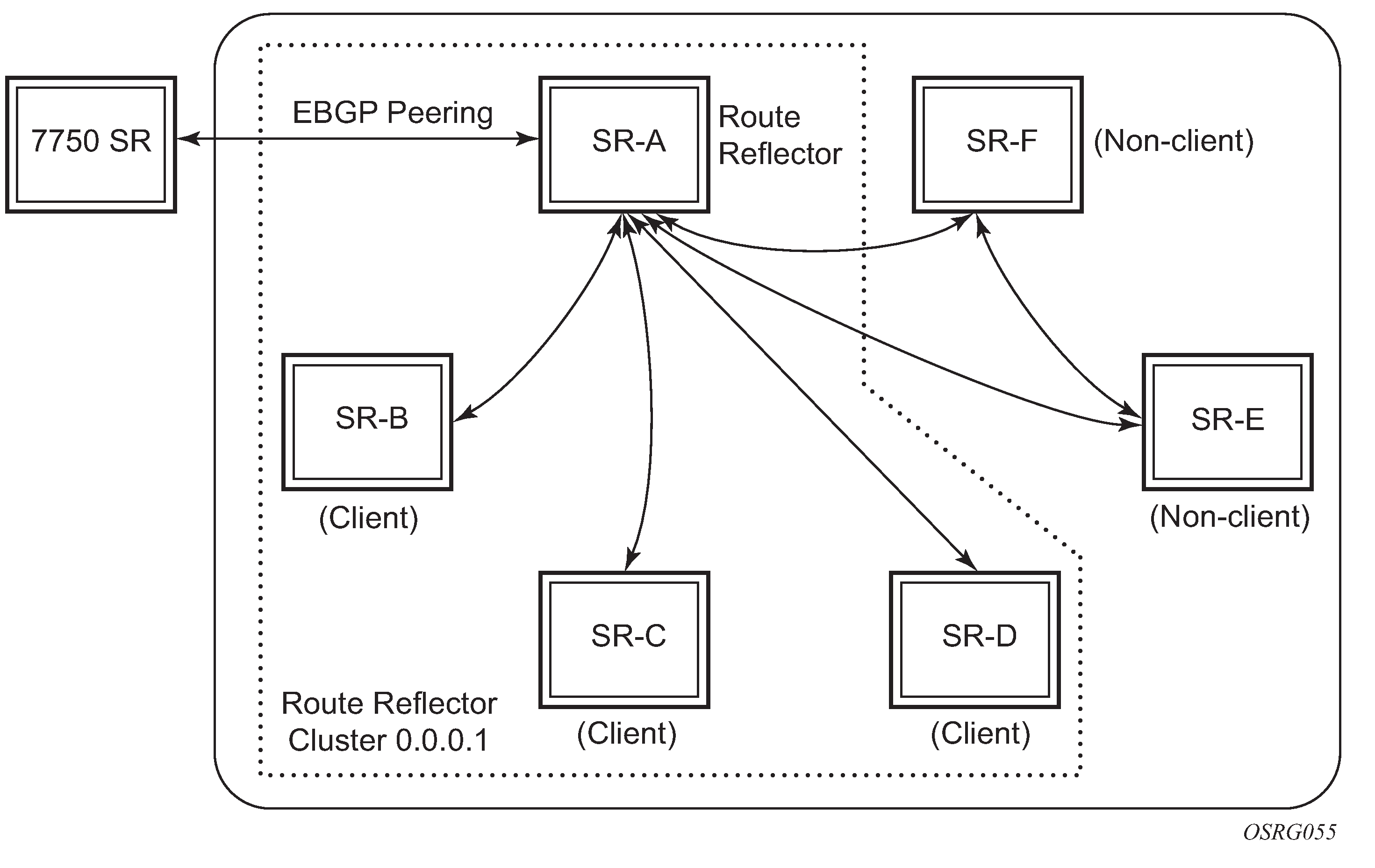In a standard BGP configuration a BGP route learned from one IBGP peer is not re-advertised to another IBGP peer. This rule exists because of the assumption of a full IBGP mesh within the AS. As discussed in the previous section a full IBGP mesh imposes specific scaling challenges. BGP route reflection eliminates the need for a full IBGP mesh by allowing routers configured as route reflectors to re-advertise routes from one IBGP peer to another IBGP peer.
A route reflector provides route reflection service to IBGP peers called clients. Other IBGP peers of the RR are called non-clients. An RR and its client peers form a cluster. A large AS can be sub-divided into multiple clusters, each identified by a unique 32-bit cluster ID. Each cluster contains at least one route reflector which is responsible for redistributing routes to its clients. The clients within a cluster do not need to maintain a full IBGP mesh between each other; they only require IBGP sessions to the route reflector(s) in their cluster. If the clients within a cluster are fully meshed consider using the disable-client-reflect functionality. The non-clients in an AS must be fully meshed with each other.
Figure: BGP configuration with route reflectors depicts the same network as Figure: Fully meshed BGP configuration but with route reflectors deployed to eliminate the IBGP mesh between SR-B, SR-C, and SR-D. SR-A, configured as the route reflector, is responsible for reflection routes to its clients SR-B, SR-C, and SR-D. SR-E and SR-F are non-clients of the route reflector. As a result, a full mesh of IBGP sessions must be maintained between SR-A, SR-E and SR-F.

A router becomes a route reflector whenever it has one or more client IBGP sessions. A client IBGP session is created with the cluster command, which also indicates the cluster ID of the client. Typical practice is to use the router ID as the cluster ID, but this is not necessary.
Basic route reflection operation (without Add-Path configured) can be summarized as follows.
If the best and valid path for an NLRI is learned from a client and disable-client-reflect is not configured then advertise that route to all clients, non-clients and EBGP peers (as allowed by policy). If the client that advertised the best and valid path is a neighbor to which the split-horizon command (at the bgp, group or neighbor level) applies then the route is not advertised back to the sending client. In the route that is reflected to clients and non-clients:
the route reflector adds an ORIGINATOR_ID attribute if it did not already exist; the ORIGINATOR_ID indicates the BGP identifier (router ID) of the client that originated the route
the route reflector prepends the cluster ID of the client that advertised the route and then the cluster ID of the client receiving the route (if applicable) to the CLUSTER_LIST attribute, creating the attribute, if it did not previously exist
If the best and valid path for an NLRI is learned from a client and disable-client-reflect is configured then advertise that route to all clients in other clusters, non-clients and EBGP peers (as allowed by policy). In the route that is reflected to clients in other clusters and non-clients:
the route reflector adds an ORIGINATOR_ID attribute if it did not already exist; the ORIGINATOR_ID indicates the BGP identifier (router ID) of the client that originated the route
the route reflector prepends the cluster ID of the client that advertised the route and then the cluster ID of the client receiving the route (if applicable) to the CLUSTER_LIST attribute, creating the attribute, if it did not previously exist
If the best and valid path for an NLRI is learned from a non-client then advertise that route to all clients and EBGP peers (as allowed by policy). In the route that is reflected to clients:
the route reflector adds an ORIGINATOR_ID attribute if it did not already exist; the ORIGINATOR_ID indicates the BGP identifier (router ID) of the non-client that originated the route
the route reflector prepends the cluster ID of the client receiving the route to the CLUSTER_LIST attribute, creating the attribute, if it did not previously exist
If the best and valid path for an NLRI is learned from an EBGP peer then advertise that route to all clients, non-clients and other EBGP peers (as allowed by policy). The ORIGINATOR_ID and CLIUSTER_LIST attributes are not added to the route.
If the best and valid path for an NLRI is locally originated by the RR (for example, it was learned through means other than BGP), it advertises that route to all clients, non-clients and EBGP peers (as allowed by policy). The ORIGINATOR_ID and CLUSTER_LIST attributes are not added to the route.
The ORIGINATOR_ID and CLUSTER_LIST attributes allow BGP to detect the looping of a route within the AS. If any router receives a BGP route with an ORIGINATOR_ID attribute containing its own BGP identifier, the route is considered invalid. In addition, if a route reflector receives a BGP route with a CLUSTER_LIST attribute containing a locally configured cluster ID, the route is considered invalid. Invalid routes are not installed in the route table and not advertised to other BGP peers.